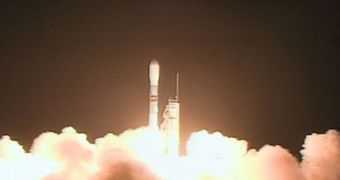After a number of delays prompted by bad weather and a minor glitch, the WISE infrared space telescope was finally launched earlier today. The new mission took off at 6:09:33 am PST (1409:33 GMT), aboard a Delta II delivery vehicle, from the Vandenberg Air Force Base, in California. The Wide-field Infrared Survey Explorer has already been in space for about 45 minutes at the time of writing, and everything appears to be running smoothly. All systems are currently working at their full capacities, NASA reports.
“Telemetry from the WISE spacecraft and the Delta II second stage report that all systems [are] working fine. The infrared telescope remains attached to the Delta II’s second stage as the two coast together. In less than 30 minutes, the second stage engine will fire again to circularize the orbit of the WISE spacecraft before the two separate,” a press release that was posted by NASA on the mission's official website at 6.30 am PST (1430 GMT) said.
“WISE is not the first infrared space telescope, but it is far more advanced than previous spacecraft. It's most direct ancestor is the Infrared Astronomical Satellite, IRAS, which orbited in 1983 to assemble the first all-sky survey in infrared. The IRAS spacecraft used detectors with a resolution of 62 pixels, the WISE will use detectors with a one million-pixel resolution. So, the WISE scan will be conducted with instruments hundreds of times more sensitive than those flown more than two decades ago,” the release added.
Other observatories, including NASA's Hubble and Spitzer Space Telescopes, the European Space Agency's (ESA) Herschel Space Observatory, and NASA's upcoming Sofia and James Webb Space Telescope, will follow up on WISE's finds. The new instrument will map the entire sky using four infrared wavelengths, the American space agency reports. “With infrared, we can find the dark asteroids other surveys have missed and learn about the whole population. Are they mostly big, small, fluffy or hard?” JPL Wise project scientist Peter Eisenhardt explained.
“We should find several hundred brown dwarfs that are currently unknown. Many brown dwarfs are too cool to be detected with visible light. WISE will see most of them. It would be quite exciting to know how many brown dwarfs there are and how old they are,” Edward L. Wright, the principal investigator of the mission, shared. He is also the David Saxon Presidential Chair in Physics and a Professor of Physics and Astronomy at the University of California in Los Angeles (UCLA).
“The infrared is important to us in astronomy because it shows us where the cool things are in the universe, things much cooler than the sun.” “The universe looks much different in infrared,” the NASA Director of Astrophysics, Jon Morse, added during a briefing on Wednesday. WISE will spend the next two weeks undergoing calibrations and other tests, before its planned seven-month mission begins.

 14 DAY TRIAL //
14 DAY TRIAL //